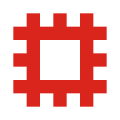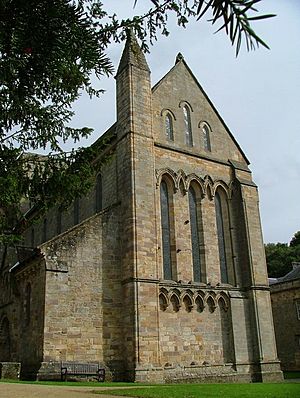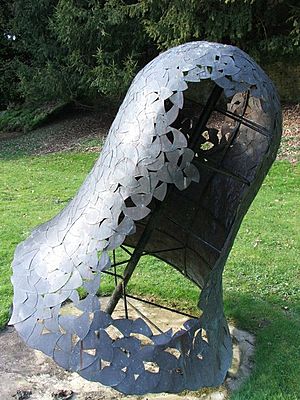Brinkburn Priory facts for kids
Quick facts for kids Brinkburn Priory |
|
|---|---|
 |
|

Brinkburn Priory church and hall
|
|
| General information | |
| Location | Northumberland, England |
| Coordinates | 55°16′44″N 1°49′01″W / 55.279°N 1.817°W |
Brinkburn Priory is an old monastery located in Northumberland, England. It sits by a bend in the River Coquet, about 4 miles (6.4 km) east of Rothbury. A monastery is a place where monks or nuns live and worship.
Today, most of the original buildings are gone. But the beautiful Priory Church still stands. It is a very important historical building, looked after by English Heritage.
Contents
What is Brinkburn Priory?
Brinkburn Priory was founded a long, long time ago. It was started by a man named William Bertram, who was a Baron. He built it during the time of King Henry I. This means it was built before the year 1135.
The Priory was home to Augustinian monks. These monks followed a special set of rules for their lives. Around the year 1180, Brinkburn became its own independent monastery. That's when they started building the main church. The church's style is a mix of older Norman and newer Gothic designs.
A Look at Its History
Brinkburn Priory owned land in Northumberland and Durham. But it was never a very rich place. We don't know much about its earliest days. We do know that the Priory faced some tough times. For example, in 1419, it was even raided and robbed!
When the Priory Closed Down
In 1536, Brinkburn Priory was officially closed. This happened because of a law called the Dissolution of the Lesser Monasteries Act. This law said that smaller monasteries, which didn't earn much money, had to close. Brinkburn Priory was one of these.
After it closed, the land mostly belonged to the Fenwick family. In the late 1500s, they built a large house. This house was built right on top of the old Priory ruins. It was also next to the Priory Church.
Church services continued at Brinkburn for a while. The church was kept in good shape until the end of the 1500s. But by 1602, it was starting to fall apart. Sometime before 1700, the roof collapsed. After that, regular church services stopped completely.
Bringing the Church Back to Life
In the 1750s, a man named Thomas Sharp tried to fix the ruined church. Many people wanted to help. But the work stopped because of an argument. It was between the owner, William Fenwick, and the local Vicar.
The Victorian Restoration
Later, in the 1800s, the Cadogan family owned Brinkburn. They decided to try and restore the church again. Work began in 1858. The roof was finished in just one year! The beautiful stained glass windows were put in by 1864. The church was fully furnished by 1868.
Today, Brinkburn Priory looks much like it did in the medieval times. The restoration work done in the 1800s was very careful. It made the church look like its original self.
During the restoration, some interesting things were found. They found the tombstone of a man named William, who was a Bishop. They also found the original altar stone. This stone had five crosses carved into it. Both of these old items are still kept at the Priory today.
Brinkburn Priory Today
Brinkburn Priory is usually a very quiet and peaceful place. Sometimes, religious services are still held there. It's also a popular spot for concerts. One famous event is the Brinkburn Festival.
Other Buildings Nearby
The old manor house next to the church is also interesting. It uses parts of the monks' old dining hall. The house looks like it was built in the 1800s. It is also a very important historical building.
There's also Brinkburn Mill. This mill was once part of the Priory's land. It was rebuilt in the 1800s. In 1990, it was fixed up by a group called the Landmark Trust.



